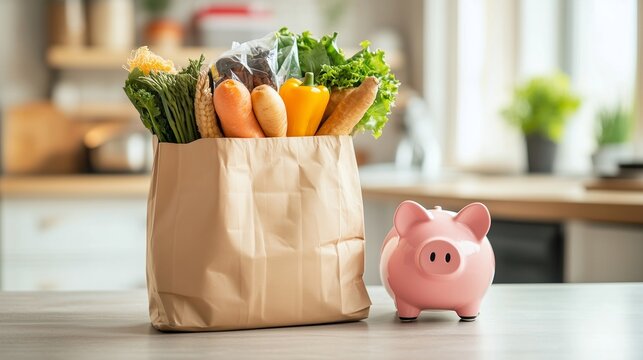Eating healthy doesn’t have to be expensive. With a little creativity, planning, and a few smart strategies, you can enjoy nutritious meals that support your well-being without spending a fortune. If you’re looking to improve your eating habits but are concerned about your budget, don’t worry — healthy eating on a budget is possible. Here’s how you can make it happen.
1. Plan Your Meals Ahead of Time
One of the best ways to save money while eating healthy is to plan your meals. Meal planning helps you avoid impulse buys and ensures you’re only purchasing what you need. You can create a weekly menu that incorporates budget-friendly ingredients and ensures you’re using leftovers efficiently.
- Tip: Start by planning for simple, balanced meals. Aim to include a variety of vegetables, whole grains, lean proteins, and healthy fats.
2. Buy in Bulk
Buying in bulk can save you a lot of money, especially on non-perishable items like grains, beans, lentils, and frozen vegetables. Bulk buying helps reduce the cost per unit, and many bulk items have a long shelf life, making them ideal for stockpiling.
- Tip: Purchase items like rice, oats, pasta, quinoa, and dried beans in larger quantities. These staples can form the foundation of numerous healthy meals.
3. Embrace Plant-Based Proteins
Animal proteins like chicken, beef, and fish can be expensive, but plant-based proteins like beans, lentils, tofu, and chickpeas are both budget-friendly and nutritious. These options are rich in protein, fiber, and other essential nutrients.
- Tip: Try swapping out meat for beans in chili, stews, and casseroles, or experiment with tofu stir-fries and grain bowls.
4. Shop Seasonal and Local Produce
Fresh fruits and vegetables are often more affordable when they’re in season. By shopping for seasonal produce, you’ll get the best prices and also ensure that you’re eating fresh, nutrient-dense foods. Farmers’ markets and local produce stands often offer great deals, especially as the season comes to a close.
- Tip: Look up a list of seasonal fruits and vegetables in your area and plan your meals around those options.
5. Freeze Leftovers
If you cook in larger quantities, freezing leftovers can be a great way to stretch your meals and avoid waste. You can portion out extras into freezer-safe containers for later use. This not only saves you time but also ensures you always have a healthy meal on hand when you’re short on time or feeling lazy.
- Tip: Cook large batches of soups, stews, or casseroles and freeze individual servings for quick lunches or dinners.
6. Cut Back on Processed Foods
Processed foods may seem convenient, but they are often more expensive and less nutritious. Instead of buying pre-packaged snacks or ready-made meals, focus on whole, unprocessed ingredients. Cooking from scratch is usually cheaper and allows you to control the quality and quantity of the ingredients.
- Tip: Skip the packaged snacks and make your own snacks like homemade granola bars, trail mix, or roasted chickpeas. It’s often cheaper and healthier!
7. Use Coupons and Shop Sales
Take advantage of sales, promotions, and coupons to save money on healthy groceries. Many stores offer discounts on produce, grains, and other staples throughout the week. Keeping an eye out for markdowns or using digital coupons can significantly reduce your grocery bill.
- Tip: Sign up for your local grocery store’s loyalty program or app to access special deals and discounts.
8. Grow Your Own Herbs and Vegetables
If you have the space, growing your own herbs and vegetables can be an incredibly cost-effective way to add fresh produce to your meals. Even a small windowsill garden can yield herbs like basil, cilantro, and parsley, which can elevate your dishes without spending extra money.
- Tip: Start with easy-to-grow herbs and vegetables, such as spinach, lettuce, or tomatoes. They don’t require much space and can be grown indoors or in small outdoor areas.
9. Focus on Nutrient-Dense, Low-Cost Foods
Some foods pack a powerful nutritional punch without costing a lot. These include oats, sweet potatoes, eggs, canned tuna, spinach, carrots, and frozen vegetables. These budget-friendly items are full of vitamins, minerals, and fiber, making them excellent additions to any diet.
- Tip: Incorporate affordable superfoods into your meals, such as leafy greens, beans, eggs, and whole grains.
10. Cook in Batches and Use Leftovers
Batch cooking allows you to make large portions of food, saving both time and money. By preparing meals in advance, you ensure that you always have something healthy and homemade on hand, reducing the temptation to buy takeout or processed food.
- Tip: Prepare meals like soups, stews, casseroles, or stir-fries in large quantities, then divide them into individual servings for quick and easy meals throughout the week.
Healthy Eating Can Be Affordable
Eating healthy on a budget is entirely possible with a little planning and mindful shopping. By embracing these tips and being strategic about your food choices, you can fuel your body with nourishing meals while keeping your finances intact. Start by making small changes to your grocery shopping and cooking habits, and gradually you’ll find that healthy eating doesn’t have to be expensive — it’s just a matter of being resourceful and smart with your choices.
Remember, health isn’t about spending more money — it’s about making smarter, well-informed choices that support your wellness and help you live a fulfilling, balanced life. Happy eating!





